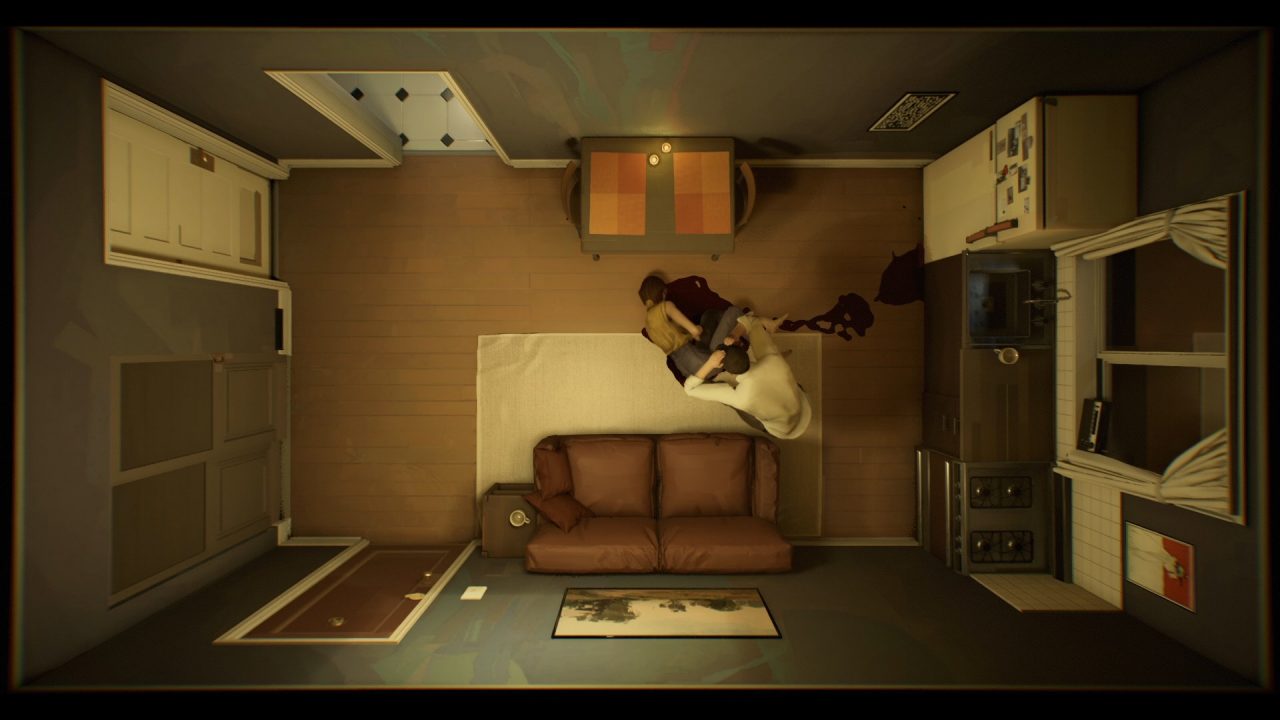Twelve Minutes captured the imaginations of gamers everywhere this year with its reveal. Society is enamored with the idea of time loops a la the movie Groundhog Day, and the unique camera angle — top-down in a tiny apartment — offered a minimalistic appeal. Willem Dafoe playing the bad guy was the cherry on top. Of course, Twelve Minutes takes a bit longer than only 12 minutes, but just how long depends on players’ frustration tolerance and curiosity.
Players inhabit a nameless protagonist in a tie who comes home to his wife in a tiny apartment with a living room, bathroom, bedroom, and closet. That’s it. Various objects can be looked at, picked up, or interacted with in some fashion, consistent with most adventure games (inventory bar at the top and the occasional mixing). The wife is another central protagonist, and much conversation takes place between the two throughout the game. When certain events occur, the loop starts again with the protagonist entering the apartment disoriented by the change in time.
Most of the play experience requires trying out new things, whether interacting with objects, engaging in new dialogue, or some combination thereof. The lead wants to know why the loops are happening, how to escape them, and how to prevent some horrific conclusions from occurring. Each loop begins innocently enough, but as the protagonist becomes more desperate and learns more about the loops and some secrets, the loops become more of an exploratory affair in which people’s emotions stop mattering, and a game of Variable Whack-a-Mole ensues.

This is where Twelve Minutes breaks down. At a certain point, everyone’s going to get stuck. How players get stuck will depend on at what point they get stuck. For me, I was initially stuck thinking I could avoid a certain outcome by “playing” differently, meaning if I could click on something fast enough or do something out of order, I could somehow change the outcome. Twelve Minutes doesn’t make it clear whether this is a possibility, as characters move from place to place for short periods. So trying to get cheeky with movement and item interactions seems plausible, but I wasn’t able to do it. After I gave up on this method, I leaned purely into dialogue options, which became incredibly dull until I discovered the big outcome.
Twelve Minutes has a few significant reveals that blow the game wide open. Players will likely bottleneck and plateau until they magically find the correct dialogue chain or think to interact with the environment and its objects a little differently. As any adventure game enthusiast understands, these moments can be exhilarating because so many options present themselves on top of the big plot reveal, but as we all know, that spark must come to an end until the next bottleneck begins.
Truthfully, the discoveries are fun, and the “a-ha” moments spark joy by letting players feel smart for a brief while. The plot and reveals are truly shocking as tastefully as one can hope given the subject matter — trying to tip-toe around spoilers here. Some players will find the game genuinely distasteful and unpleasant, but I think most can stomach it. For the most part, the topics are handled with a degree of tact and respect; most players will find the frustration with controls and gates more discouraging.

Immediately, Twelve Minutes feels like it lags a bit. The main character moves in a clunky fashion with an odd stiffness that makes him more resemble a mannequin than a person. Fortunately, this discomfort subsided for me quickly as I became engrossed in the mystery; then, it revealed itself again as I tried to manipulate sequences, as I mentioned earlier. What doesn’t help are the graphical limitations, but given the camera angle, the visuals don’t feel so important.
But what about Mr. Dafoe and the rest of the cast? The voice acting is commendable, of course, and while Dafoe puts on a wonderful performance, the limitation of his character wastes his talent. Musically, not only do the themes weave in and out of scenes smoothly, but they add much-needed tension at the right moments.
Twelve Minutes is an exercise in patience and the thrill of discovery. Many will tap out before discovering all of the endings or the true ending, whatever that is. I tossed in the towel after about six hours because I passed a point-of-no-return that the game alluded to but didn’t make it explicitly clear to me. The idea of having to redo everything I had already done was unthinkable, so I quit. I had gotten a couple of endings at that point, so I was satisfied enough. I imagine this will be a title that enthusiasts will speculate on and theorize over for a long while, while others will pass on it in frustration as it leaves a bad taste in their mouths. Although not totally satisfying, I’m glad I played it, and I think for the right person, this is a rewarding and thought-provoking adventure.


